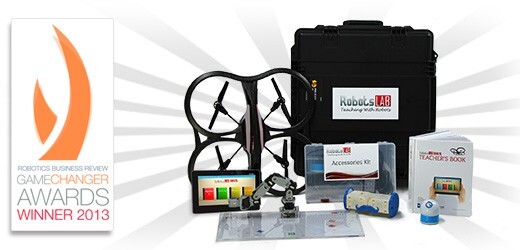RobotLAB Blog
Everything You Need To Know About Robotics in Businesses
Oklahoma public schools are boosting their STEM learning with RobotsLAB BOX
Oklahoma public schools are about to receive an enormous boost to their STEM learning programs. The innovative Oklahoma City STEM learning facility techJoynT has teamed with us here at RobotsLAB in San Francisco to bring our award winning RobotsLAB BOX with its innovative math teaching aids to public school students in the state. Yes, the study of math is about to become exciting!
As those of you familiar with this blog are aware, our BOX is designed to assist math educators in teaching abstract math concepts by engaging students with robots. And as Dr Peter Stone, Alfred P. Sloan Research Fellow, Guggenheim Fellow, AAAI Fellow, Fulbright Scholar, and Professor in the Department of Computer Science at the University of Texas at Austin, explains “You don’t need to be experienced with robotics or have a degree in computer science, just an enthusiasm for your subject area...You can open the BOX, turn on the preloaded tablet and within minutes be explaining quadratic equations with a quad copter.” This beats pontificating in front of a blackboard every time!
- 0 Comments
- Jan 31, 2014 6:02:00 PM
- Posted by Charles Nimrad
- Topics: Math, About the BOX, Local News, EdTech, STEM, Education, 21st Century Classroom, School, Student Engagement
5 Tools Everyone In The Educational Robotics Industry Should Be Using
Of course the first answer to the question posited by the title of this piece is a facetious one--lots of money! So let us qualify the question a bit more by asking, "What are 5 tools everyone in the educational robotics industry should be using that most of us in the industry can afford?"
Since learning to code is so important to any STEM discipline, the first tool everyone in the educational robotics industry should be using is the online community and programming language called Scratch. This innovative site helps kids learn its namesake programming language and create interactive stories, games and computer animations. This outstanding tool is actually free!
Since math is basic to any scientific endeavor, the ability to interest and engage students in math is crucial to the educational robotics industry. Our second tool that everyone in the industry should be using, the RobotsLAB BOX, has proved its ability to interest and engage kids in math with an innovative combination of robots and tablets in many progressive school districts. The old teaching standbys like the book and the whiteboard can’t compete with "cool" robot helicopters demonstrating quadratic equations in real-time on a tablet.
- 0 Comments
- Jan 24, 2014 12:00:00 PM
- Posted by Elad Inbar
- Topics: Math, Robotics, Teaching with the RobotsLAB BOX, About the BOX, EdTech, STEM, Education, Computer Science, NAO, code, 21st Century Classroom, School, Student Engagement, Middle School
How To Solve The Biggest Problem With STEM Education
Judging from the number of e-gadget users in this country, technology is all the rage. Over 90% of adults have a cell phone. Thirty-four percent (34%) own a tablet. And no one doubts that the percentages will continue to rise. One might also be forgiven for thinking our schools are up to the job of graduating the vast numbers of science, technology, engineering and math students needed to keep this country in the forefront of this technology wave--the interest is obviously there. Unfortunately that is not the case!
By 2018--now less than 4 years and a single generation of high school students away--we are expecting at least 8 million jobs in the US dependent on skills learned in STEM learning courses. But experts estimate that less than five million of those jobs will go to kids from American schools, with three million or more of these well-paid positions going to foreign applicants.
Why is this happening? Why can’t our schools keep up with the demand for young people trained in science, technology, engineering and math? Well as you might expect there are all sorts of excuses for this, from lack of funding to a lack of interest in STEM learning on the part of students themselves. We at RobotsLAB can’t do much about the funding issue; that requires political action. What we can do is help change the culture of math education.
- 0 Comments
- Jan 23, 2014 10:00:00 AM
- Posted by Mike Nardine
- Topics: Math, Teaching with the RobotsLAB BOX, About the BOX, EdTech, STEM, Education, 21st Century Classroom, Student Engagement, Middle School
Augmented Reality practice in math classroom?
What the heck is “augmented reality?” That was my first thought when first seeing the phrase in a related post. No, I take that back; to tell the truth, like most people I asked, I thought it was merely another way to say “virtual reality.” But It most certainly isn't...
This according to the Wikipedia: Augmented reality (AR) is a live, direct or indirect, view of a physical, real-world environment whose elements are augmented (or supplemented) by computer-generated sensory input such as sound, video, graphics or GPS data. By contrast, virtual reality replaces the real world with a simulated one.”
Let’s put it another way: augmented reality is to The Minority Report with Tom Cruise as virtual reality is to Inception with Leonardo Dicaprio. Remember in The Minority Report when Tom Cruise stood facing a huge transparent computer screen manipulating images and data with gloved hands? That manipulation, a combination of real objects (gloved hands) and digital reality (data and images), makes for a perfect example of augmented reality (a teacher holding the control tablet from the RobotsLAB BOX in his hand can impose data on the real world the way Tom Cruise did--and he wouldn’t have to wear gloves!) On the other hand, Leonardo DiCaprio's avatar immersed in a simulated dreamworld, is a perfect example of virtual reality.

- 0 Comments
- Nov 25, 2013 11:29:51 PM
- Posted by Mike Nardine
- Topics: Math, About the BOX, EdTech, 21st Century Classroom, algebra,
ROBOTSLAB BOX IS A FINALIST FOR THE GAME CHANGERS AWARDS
UPDATE: OCt. 23rd - RobotsLAB BOX is the winner of the "Game Changer" Award
- 0 Comments
- Oct 16, 2013 7:16:00 PM
- Posted by Brendan Barnard
- Topics: About the BOX, EdTech, STEM, Awards, Press
ROBOTS: THE NEWEST MILESTONE IN SCIENCE LEARNING

- 0 Comments
- Oct 8, 2013 6:00:00 PM
- Posted by Brendan Barnard
- Topics: About the BOX, EdTech, Education
BLENDED LEARNING PAVES WAY FOR DIGITAL CONTENT
Most of us are aware that blended learning means integrating face-to-face classroom instruction with online learning.
The benefits of blended learning are many, including allowing greater leeway for students to work at their own pace and take a lot more courses than they might otherwise have had access to at their own local schools. Think of it as an educational leveler.
But as Bob Wise, former governor of West Virginia and president of the Alliance for Excellent Education opined at a recent panel discussion, "Blended learning is not using technology to diminish the role of teaching, it enhances the role of teaching."
- 0 Comments
- Oct 2, 2013 11:03:00 AM
- Posted by Brendan Barnard
- Topics: Math, About the BOX, EdTech, STEM
SPREADSHEETS CAN HELP STUDENTS GET FROM ARITHMETIC TO ALGEBRA
- 0 Comments
- Sep 17, 2013 3:09:00 PM
- Posted by Brendan Barnard
- Topics: About the BOX, EdTech, Education
TEACHING THE LAW OF COSINES WITH ROBOTS

Who doesn’t like seeing Optimus prime fight Megatron? Or one of the robots in “Pacific Rim” use an oil tanker to fight one of the monsters? Well controlling a robot, large or small, involves the use of cosines, among other mathematical equations. However, cosines, like quadratic equations and vectors, are hard to understand using just a math book. Unless your students are really interested in figuring out how tall buildings are, they may not care to learn how cosines factor into things like designing and building a roof. RobotsLAB solves this problem by stripping down the concept of cosines to their core functionality, giving the students something physical (and pretty cool) to look at and makes the concept easier to understand.
- 0 Comments
- Aug 26, 2013 3:01:00 PM
- Posted by Brendan Barnard
- Topics: Math, About the BOX, EdTech, Education
DEMONSTRATING QUADRATIC EQUATIONS IN THE REAL WORLD
Quadratic Equations are one of the more abstract mathematical concepts for high school students. Even if you can remember and solve the formulas, it’s hard for teens to think about how quadratic equations could ever help them in their future job, or even how they could save a life. It is the main goal of the RobotsLAB BOX to help bridge the gap between concepts and what they truly mean in a world that doesn’t revolve around white boards and exams.
- 0 Comments
- Aug 9, 2013 4:30:00 PM
- Posted by Brendan Barnard
- Topics: Math, About the Robots, About the BOX, EdTech, STEM, Education
Relevant Posts
- Augmented Reality: A Tool for Teaching Students Robot Programming
- Fostering Innovation Through Youth Education in STEM and EdTech
- How Parents Can Foster STEM Learning Beyond the Classroom
- How Robotics Cultivates a Deep Understanding of Mathematics in Students
- RobotLAB Receives EDTech Chronicle 2023 ‘BESTIE’ Award for Landmark Partnership with American Samoa Dept. of Education.
Subscribe to Email Updates
-
I Want To Learn MoreADDITIONAL INFORMATION
